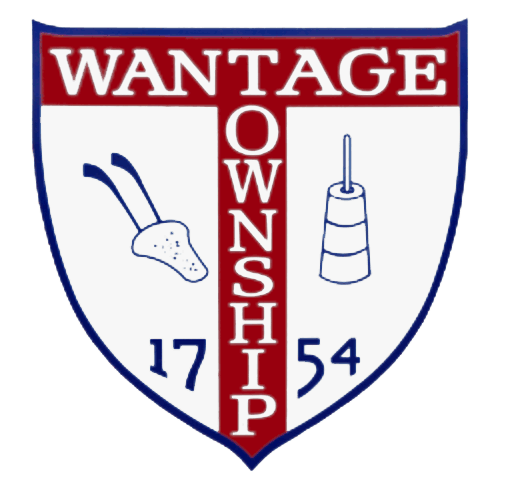Historic Wantage Township
Named for Wantage, England, Wantage Township was formed as a precinct on May 30, 1754, from portions of Newton Township. It was incorporated as a Township on February 21, 1798, as part of the state's initial group of 104 townships. Boundary exchanges were made with Frankford Township in both 1826 and 1834. Portions of the township were taken on October 14, 1891, to form the Borough of Deckertown, which was renamed Sussex Borough in 1902.
Historic Designations
- Deckertown Papakating Cemetery, Cemetery Road
- Lusscroft, County Route 519
- Kilpatrick's Reenactment, County Route 560
- Goldsmith Maid, 51 Unionville Road
- The Old Clove Church, Rt 23N
Historical Society
The Sussex-Wantage Historical Society was founded on March 19, 2015 to promote education, public knowledge, and interest in the history of Sussex Borough and Wantage Township. The group hosts historical walking tours and presentations, participates in Sussex County History Day, and publishes articles about historical places and people. The website is sussex-wantagehistoricalsociety.org. Direct emails to swhistoric@gmail.com.
Historical Wantage Map
The Friends of the Sussex-Wantage Library produced a historical map of Wantage. It is a great resource that shows many historic locations in Wantage Township. Maps are $5 and can be purchased at the library and at the used books sales.
Historical Markers
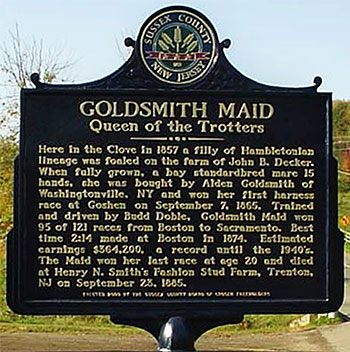
Goldsmith Maid - Queen of the Trotters
Location: Kuperus Farm, 51 Unionville Road (County Route 651)
Date of Marker Placement: 2009
Marker Text: Here in the Clove in 1857 a filly of Hambletonian lineage was foaled on the farm of John B. Decker. When fully grown, a bay standardbred mare 15 hands, she was bought by Alden Goldsmith of Washingtonville, NY and won her first harness race at Goshen on September 7, 1865. Trained and driven by Budd Doble, Goldsmith Maid won 95 of 121 races from Boston to Sacramento. Best time 2:14 made at Boston in 1874. Estimated earnings $364,200, a record until the 1940's. The Maid won her last race at age 20 and died at Henry N. Smith's Fashion Stud Farm, Trenton, NJ on September 23, 1885.

Dar Van Bunschooten Museum
Location: Daughters of the American Revolution (DAR), 1097 Route 23 North
Date of Marker Placement: 2006
Marker Text: This house was built in 1787 as the home of the Reverend Elias Van Bunschooten, a Dutch Reformed Minister. He was a farmer, mill operator, and large land owner. The farm was part of a 1000 acre plantation. The Dutch Colonial house is post and beam construction. Out buildings include a Wagon House, Ice House, and a Privy. The home was given to the Chinkchewunska Chapter of the Daughters of the American Revolution by Mr. & Mrs. Clifford Ramsey in 1971. The house and out buildings were listed on the National Register of Historic Sites and Places in 1974.
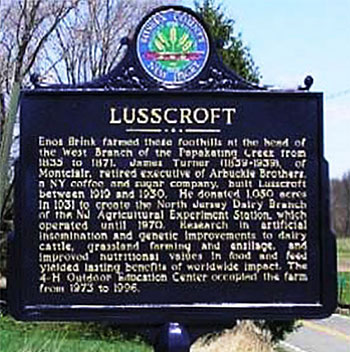
Lusscroft
Location: Lusscroft Farm, Route 519 (farm entrance is 50 Neilson Rd.)
Date of Marker Placement: 2006
Marker Text: Enos Brink farmed this foothills at the head of the West Branch of the Papakating Creek from 1835 to 1871. James Turner (1859-1939), of Montclair, retired executive of Arbuckle Brothers, a NY coffee and sugar company, built Lusscroft between 1919 and 1930. He donated 1,050 acres in 1931 to create the North Jersey Dairy Branch of the NJ Agriculture Experiment Station, which operated until 1970. Research in artificial insemination and genetic improvements to dairy cattle, grassland farming and ensilage, and improved nutritional values in food and feed yielded lasting benefits of worldwide impact. The 4-H Outdoor Education Center occupied the farm from 1973 to 1996.
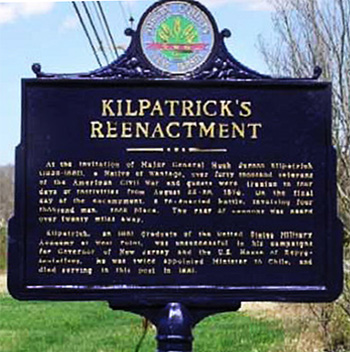
Kilpatrick's Reenactment
Location: Sussex County Route 650, just north of Lake Neepaulin
Date of Marker Placement: 2003
Marker Text: At the invitation of Major Hugh Judson Kilpatrick (1836-1881), a native of Wantage, over forty thousand veterans of the American Civil War and guards were treated to four days of festivities from August 25-28, 1878. On the final day of the encampment, a re-enacted battle involving four thousand men, took place. The roar of cannons was heard over twenty miles away.
Kilpatrick, an 1861 graduate of the United States Military Academy at West Point, was unsuccessful in his campaigns for Governor of New Jersey and the U.S. House of Representatives. He was twice appointed Minister to Chile, and died serving in this post in 1881.
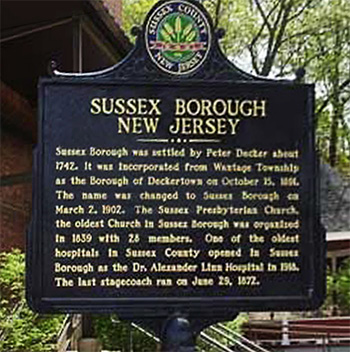
Sussex Borough
Location: Sussex Borough, Main Street at the Deckertown Commons Park
Date of Marker Placement: 2008
Marker Text: Sussex Borough was settled by Peter Decker about 1742. It was incorporated from Wantage Township as the Borough of Deckertown on October 15, 1891. The name was changed to Sussex Borough on March 2, 1902. The Sussex Presbyterian Church, the oldest Church in Sussex Borough was organized in 1839 with 28 members. One of the oldest hospitals in Sussex County opened in Sussex Borough as the Dr. Alexander Linn Hospital in 1918. The last stagecoach ran on June 29, 1872.
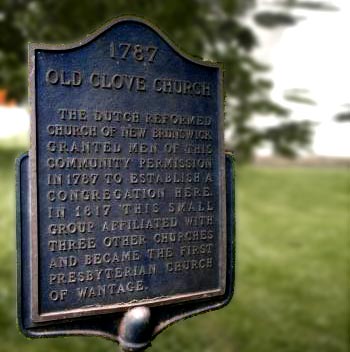
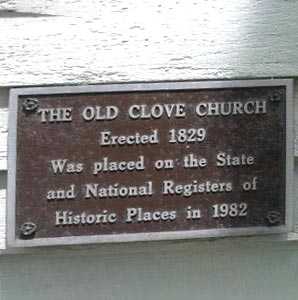
Old Clove Church
Location: Wantage Township, Rt 23N, across from the Municipal Building.
First marker: roadside.
Second marker: on church's outer wall near church doors.
First Marker Text: The Dutch Reformed Church of New Brunswick granted men of this community permission in 1787 to establish a congregation here. In 1817 this small group affiliated with three other churches and became the First Presbyterian Church of Wantage.
Second Marker Text: The Old Clove Church Erected 1829 Was placed on the State and National Registers of Historic Places in 1982.
The building is no longer used for regular services. The church is occasionally used for funerals and weddings.
Old Clove Church
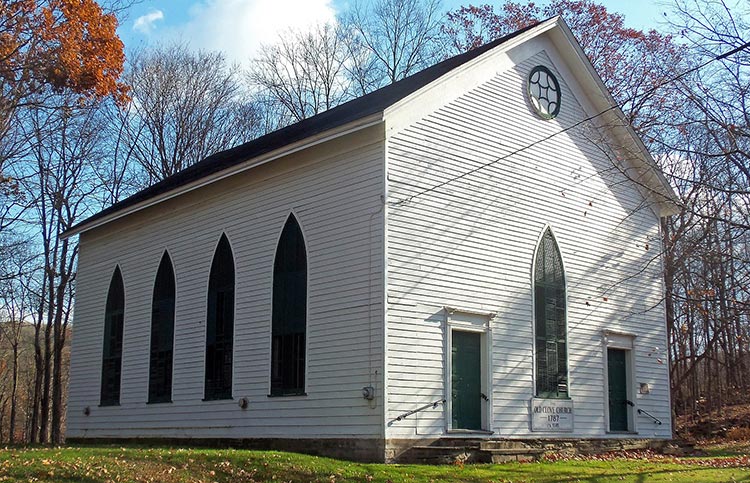
The original congregation of the Old Clove Church was formed in 1787. The pastor was Rev. Elias Van Bunshooten. For a time the congregation met in a barn until a log meeting house was built just south of the church's present location.
In 1814, Rev. Van Bunshooten gave the trustees of Queen's College (now Rutgers University) a fund of $17,000; the income from which was to be applied to the education of ministers. This fund is still active and continues to educate ministers. It is the oldest such endowment in the United States.
After Van Bunshooten's death in 1815, the church members voted to disband. On August 11, 1818 it was organized as a Presbyterian church with 25 members under the Ref. Gershon Williams as the First Presbyterian Church of Wantage.
In 1821, the Rev. Edward Allen was installed as pastor, serving until 1830. There were two very successful religious revival meetings held at the church at this time, which added 342 members to the church. The log meeting house was now too small to accommodate everyone and it was torn down. The present church was built in 1829 for $3,300 by Andrew McNish, with much of the labor contributed by members of the congregation.
The building is architecturally unique and is an early example of transitional architecture, combining Greek Revival and Victorian Gothic Styles. The foundation is laid without cement and is made of squared blocks of stone.
Rev. Allen resigned because of ill health and was succeeded by Rev. Peter Kanouse who served from September 27, 1830 until December 29, 1834. Two more revivals were held, and 163 members were added to the church, bringing the membership to 600.
On July 13, 1834, the congregation of Old Clove Church was divided and the Second Presbyterian Church of Wantage in Beemerville was organized with 122 members. Old Clove Church was again divided on May 1, 1839 and the Third Presbyterian Church of Wantage in Deckertown (now Sussex) was organized.
Church services were well attended. Horse drawn carriages would pull around the outside of the crowded church and members would listen to the service through the windows.
During the late 1800's, ministers stayed with various families and walked from farm to farm to spread their word. The nearby Old Clove Church has headstones denoting the early church members, and a small section is the final resting place for slaves. Students at Mount Retirement Seminary, a local boarding school, which opened in 1883, attended services at Old Clove Church.
Harvest Home suppers were held on the church lawn under tents. Music was supplied by local musicians. Oil Lanterns were strung across the church grounds to provide light in the evening for suppers.
In 1887, in honor of a 100-year existence of both the Reformed and Presbyterian congregations, the pews were cut down and outlined in black walnut. Large Victorian stoves were placed on both sides and Gothic style apse chandelier was hung and the candle sconces were removed from the pillars where their original positions show plainly.
In the early 1900's the congregation began to decline and from 1914 to 1928, services were held during the summer months by theological students. Since then an annual service has been held with guest minister.
In 1972 the Newton Presbytery wished to dispose of the property and a group of friends and old members raised $7,000 to purchase the building and the land. Today, the church stands much as it did when the 1887 celebration was held. Occasionally, the church is used for funerals and weddings.
In June of 1982, the Old Clove Church was placed on the New Jersey and National Registers of Historic Places.
